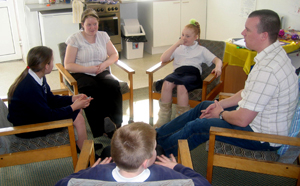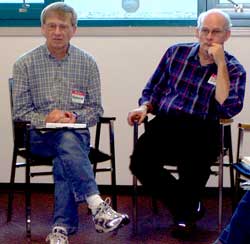News & Announcements
- Details
- Written by Laura Mirsky
 Students at St. James Primary School participate in a restorative circle facilitated by Mark Finnis, restorative justice development officer at the Sefton Centre for Restorative Practice.The Sefton Centre for Restorative Practice has a goal—to create a restorative community. The brainchild of Sefton Youth Offending Team (YOT) manager Steve Eyre, the center may be the only building in the UK dedicated to restorative practices. (There are 154 multi-agency YOTs under the guidance of the Youth Justice Board in all of the local authorities in England and Wales, made up of representatives from probation, education, social services, health and police. Their principal aim is to stop and prevent young people from committing offenses by providing programs and interventions to both the court and the young offenders themselves.)
Students at St. James Primary School participate in a restorative circle facilitated by Mark Finnis, restorative justice development officer at the Sefton Centre for Restorative Practice.The Sefton Centre for Restorative Practice has a goal—to create a restorative community. The brainchild of Sefton Youth Offending Team (YOT) manager Steve Eyre, the center may be the only building in the UK dedicated to restorative practices. (There are 154 multi-agency YOTs under the guidance of the Youth Justice Board in all of the local authorities in England and Wales, made up of representatives from probation, education, social services, health and police. Their principal aim is to stop and prevent young people from committing offenses by providing programs and interventions to both the court and the young offenders themselves.)
For nearly two years, with training and assistance from IIRP affiliate Real Justice UK, the center’s team—including Eyre, line manager John Gibbens, restorative justice facilitator Paul Moran, restorative justice development officers Mark Finnis and Paula Downes, police officer Malcolm McConchie, senior prevention manager Carol Jenkinson, victim inclusion officers Sylvia Bouqdib and Sharon Jones and support staffer Carla Cunningham—has been implementing restorative practices across the board in Sefton.
- Details
- Written by John Boulton
The Bessels Leigh School, in Abingdon, Oxfordshire, England, a residential special school for boys with emotional and behavioral difficulties, age 11-16, has seen a remarkable change in culture, due to restorative practices.
Via restorative processes both formal and informal, the approximately 28 pupils are encouraged to express their emotions and feelings and consider those of others. In a very powerful way they are made aware of the consequences of their behavior and can recognize the harm that their actions have caused. In partnership with the IIRP and Real Justice UK and SaferSanerSchools UK, Bessels Leigh School is on track to become a demonstration school for restorative practices in the UK.
Established in 1964, Bessels Leigh School formerly served mostly pupils at the milder end of the behavioral spectrum. The philosophy was traditional, structured and authoritarian. Pupils and staff were generally happy, boundaries were not severely tested, pupil-staff relationships were mostly positive and staff turnover was low.
- Details
- Written by IIRP
This article in the UK''s Guardian newspaper reports on a survey showing that nearly two-thirds of a random sampleof 991 adult victims of crime believe that prison sentences don''tprevent reoffending. More than half favor face-to-face meetings betweenvictims and offenders, so victims can relate the impact of the crimeand offenders can take responsibility and make amends.
- Details
- Written by IIRP
A report on the conference, including a detailed conference schedule and papers related to plenary and breakout sessions.
- Details
- Written by Wanchai Roujanavong
Paper by Wanchai Roujanavang, director general of the Department of Juvenile Observation and Protection, Thailand Ministry of Justice, presented in a plenary session at "The Next Step: Developing Restorative Communities," the IIRP''s 7th International Conference on Conferencing, Circles and other Restorative Practices, in Manchester, England, UK, November 9-11, 2005.
- Details
- Written by Graham Robb
Paper by Graham Robb, advisor for the Behaviour and Attendance Program, Department for Education and Skills, England, presented in a plenary session at "The Next Step: Developing Restorative Communities," the IIRP''s 7th International Conference on Conferencing, Circles and other Restorative Practices, in Manchester, England, UK, November 9-11, 2005.
- Details
- Written by Michael Michiels, Elisabeth Vandenbogaerde
Paper by Belgian youth workers Elisabeth Vandenbogaerde and Michael Michiels, presented in a plenary session at "The Next Step: Developing Restorative Communities," the IIRP''s 7th International Conference on Conferencing, Circles and other Restorative Practices, in Manchester, England, UK, November 9-11, 2005.
- Details
- Written by Rev. Benjamin Shortridge
Paper by Rev. Benjamin Shortridge, founder and executive director of Los Angeles Family and Community Empowerment Services, presented in a plenary session at "The Next Step: Developing Restorative Communities," the IIRP''s 7th International Conference on Conferencing, Circles and other Restorative Practices, in Manchester, England, UK, November 9-11, 2005.
- Details
- Written by Ted Wachtel
Paper by IIRP president and founder Ted Wachtel, presented in a plenary session at "The Next Step: Developing Restorative Communities," the IIRP''s 7th International Conference on Conferencing, Circles and other Restorative Practices, in Manchester, England, UK, November 9-11, 2005.
- Details
- Written by Andrew McWhinnie
 CoSA volunteers Bernie Martens (left) and Wayne Northey participate in a training event in Abbotsford, British Columbia, Canada.“Robert” was released from a Canadian penitentiary in 1994. He had a very long history of assaulting little boys. He was fearsome. He embodied the stereotypical image of the ham-fisted monster hiding behind telephone poles, waiting to snatch an unsuspecting child. The research tells us few such offenders lurk in our midst, but Robert (not his real name) was one of those few. The sentencing court had not declared Robert a dangerous offender. Had it done so, he would have remained in prison indefinitely. Soon, however, he was to be released, and everyone who knew him dreaded the day.
CoSA volunteers Bernie Martens (left) and Wayne Northey participate in a training event in Abbotsford, British Columbia, Canada.“Robert” was released from a Canadian penitentiary in 1994. He had a very long history of assaulting little boys. He was fearsome. He embodied the stereotypical image of the ham-fisted monster hiding behind telephone poles, waiting to snatch an unsuspecting child. The research tells us few such offenders lurk in our midst, but Robert (not his real name) was one of those few. The sentencing court had not declared Robert a dangerous offender. Had it done so, he would have remained in prison indefinitely. Soon, however, he was to be released, and everyone who knew him dreaded the day.
Harry Nigh, a Mennonite pastor in Hamilton, Ontario, a medium-sized city close to Toronto, took a call from a prison psychologist who was working with Robert leading up to his release. Robert had been to Harry’s “Welcome Inn” church in Hamilton before he was arrested and had identified Harry as a possible community support when he was released.

Restorative Works Year in Review 2024 (PDF)
All our donors are acknowledged annually in Restorative Works.
